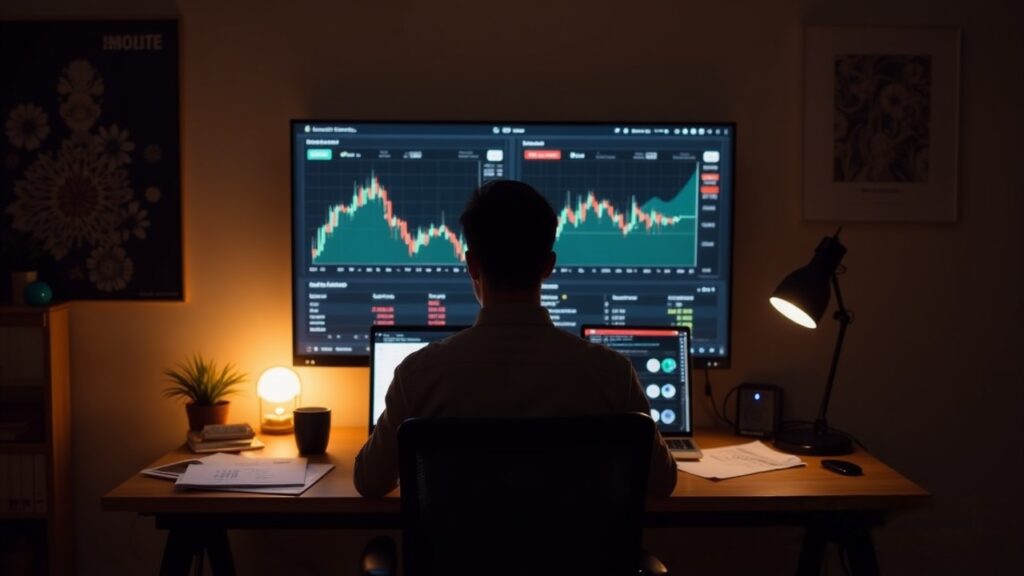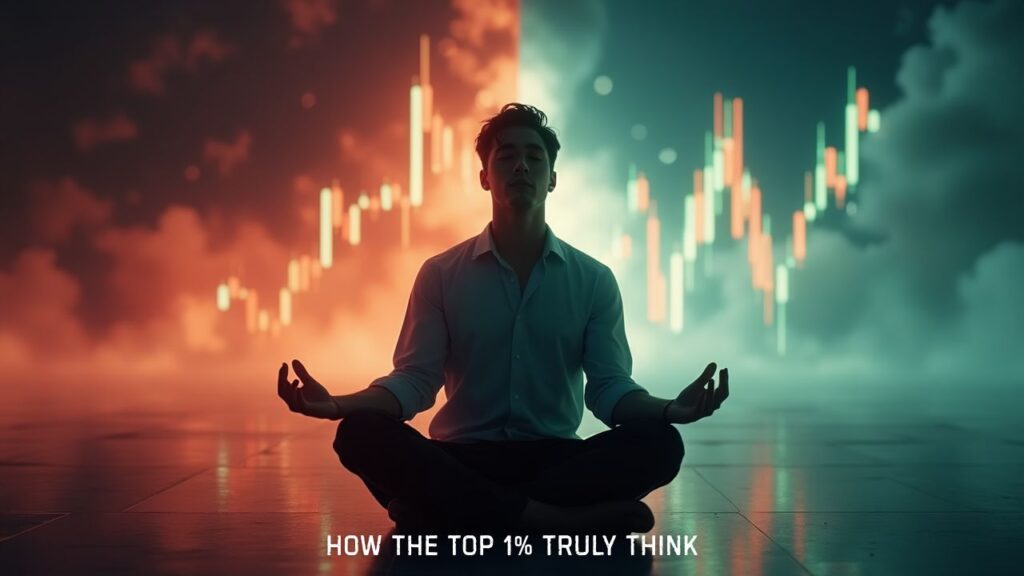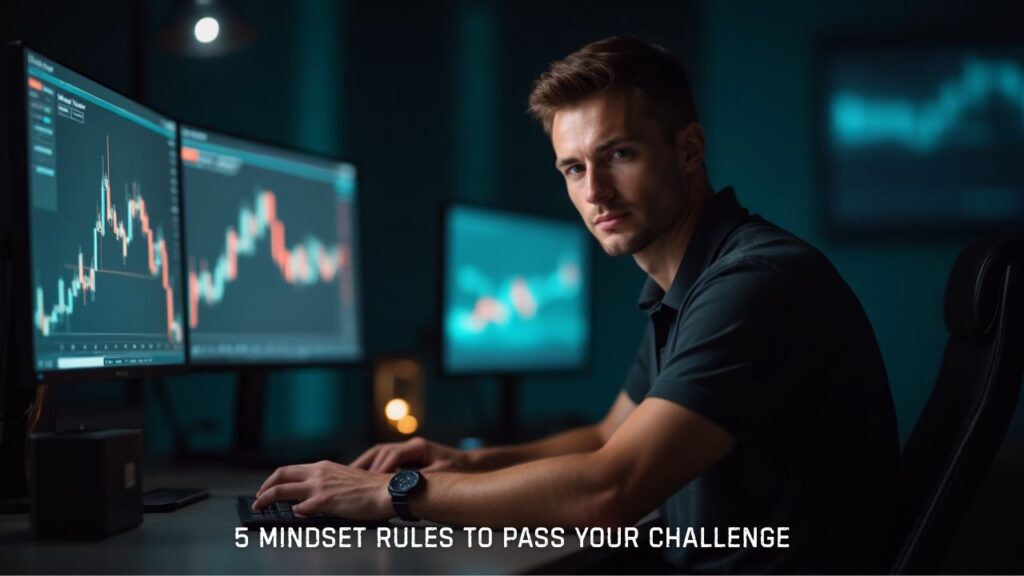You can have every tool imaginable, premium TradingView, dual monitors, dozens of indicators but it won’t make you profitable if your trading mindset isn’t strong. Success comes from emotional control, discipline, and self-awareness, not fancy charts. This article will guide you step by step to build the real edge inside your head.
Tools Don’t Make Traders. Mindset Does
I’ve seen it too many times. Traders stack technical indicators, subscribe to every premium service like Seeking Alpha and Motley Fool, and follow every market signal. Yet, they still fail.
The truth? More data doesn’t guarantee better performance. You could have a MarketWatch dashboard on one screen, TradingView on the other, alerts pinging every minute and still watch your account bleed.
The reason is simple: the real edge isn’t in the platform. It’s in your ability to remain disciplined, emotionally neutral, and focused under pressure. That’s the foundation of trading psychology.
The Mirage of the “Perfect Setup”
New traders often chase the illusion of perfection. “If I just add one more indicator, tweak this setting, or layer another chart, profits will come.” But here’s the brutal truth:
“A fool with a tool is still a fool.” Grady Booch
No platform, no matter how advanced, can stop revenge trading, FOMO entries, or cutting winners too early. These are not technical issues, they’re psychological ones.
Also read this: The Psychology Behind Revenge Trading and How to Stop
What TradingView Can Do (and What It Can’t)
| Feature | What It Offers | What It Can’t Do |
|---|---|---|
| Indicators & Signals | Chart-based entry and exit alerts | Emotional discipline |
| Alerts & Automations | Timely notifications | Impulse control |
| Multi-Timeframe Analysis | Confirms bias visually | Detachment from outcome |
| Backtesting Strategies | Historical performance review | Real-time decision-making under stress |
| Journal integrations | Track trades and results | Force honest self-reflection |
TradingView is brilliant, but only in the hands of a disciplined mind. Without emotional control and self-awareness, all its features become distractions.
The Real Edge: Your Mindset
Think about it: technical setups are common. Mental resilience is rare. That’s your competitive advantage.
- Calmly endure drawdowns
- Sit on your hands when needed
- Admit mistakes without ego
- Follow your plan consistently
“In trading, it’s not about being right. It’s about surviving wrong.” Brett Steenbarger
Your success isn’t about charts. It’s about choices. Trading psychology is what separates profitable traders from the rest.
Mental Pitfalls Traders Ignore
While many obsess over indicators, they often overlook these traps:
1. Over-Optimization Bias
One more tweak, one more indicator, one more backtest. You can’t optimize your way out of poor discipline. Impulse trades, abandoning risk rules, and emotional mistakes will still happen.
2. Tool Worship
Treating platforms, indicators, or automated alerts as saviors is a mistake. Trading is not plug-and-play. Charts don’t make decisions, you do. Without a trained trader mindset, you’re vulnerable when markets test your patience.
3. Avoidance Behavior
Constantly tweaking colors, replaying tutorials, or backtesting endlessly isn’t always research, it’s avoidance. Avoiding journaling, emotional checks, or facing internal weaknesses.
“We are blind to our own blindness.” Daniel Kahneman
Until you recognize your blind spots, better-looking charts won’t solve anything.
Case Study: Same Tools, Different Mindsets
| Trader | Setup | Mindset & Practices | Result |
|---|---|---|---|
| Trader A | Premium TradingView, 15+ indicators, news obsession | Impulsive, emotionally reactive | Losing consistently |
| Trader B | Free TradingView, 2 indicators, simple support/resistance | Journals daily, practices breathwork, patient | Profitable and calm |
Same market, same charts, but only Trader B thrived, thanks to psychological discipline.
What Traders Should Focus On
Stop chasing the perfect setup. Focus on yourself.
Morning Mindset Rituals
Prepare before charts:
- Meditation regulates nerves
- Visualization wires your brain for plan-following
- Emotional temperature checks identify stress or impatience
These simple habits condition your mind for consistent execution.
Real Journaling
Capture what charts can’t show:
- Thoughts before each trade
- Emotional state (calm, anxious, impulsive)
- Reasoning behind every decision
Patterns repeat until noticed. Journaling builds self-awareness, not just records.
Free Journaling Tool: Access the Reborn Trading Journal Here
Pre/Post Trade Checklist
Like a pilot, check before and after every trade:
- Rate confidence (your state, not trade quality)
- Note emotional state
- Write one lesson per trade
Self-Awareness During Sessions
Ask:
“Am I trading my plan or my mood?”
Fear, boredom, and revenge trading cause 80–90% of retail losses. Control reactions, not the market.
How to Build a Trader’s Mindset: Step-by-Step
1. Mental Fitness Routine
- Cold showers, walks, journaling
- Focus on clarity over control
2. Environment Check
- Declutter workspace
- Remove dopamine triggers
3. Emotional Playbook
- Identify patterns: fear, greed, anger
- Write rules for each emotional state
4. Embrace Consistency
- Fewer trades, simpler setups, more focus
“Your personal behavior is more important than your investment behavior.” Morgan Housel
Want to Trade Mindfully?
You don’t need another chart or indicator, you need guidance to strengthen your trading mindset. Here’s how you can start:
- Join The Reborn Trader Newsletter: Get weekly insights, actionable routines, and mindset strategies delivered straight to your inbox. Perfect for building emotional discipline, consistency, and focus. Sign up here
- 1-on-1 Mindset Coaching Sessions: Work directly with me to identify your emotional patterns, implement pre/post trade checklists, and build a personalized plan for trading psychology mastery. Ideal if you want fast, guided results. Book your session
Remember: TradingView is your map, but your mindset is the driver. Start training your mind, and the trades will follow.
FAQs
Is TradingView enough to become a successful trader?
TradingView is a powerful technical analysis tool, but it’s not enough on its own. Success in trading requires discipline, emotional control, and a strong trading mindset, none of which can be automated by any charting platform.
What is the most important skill in trading?
Emotional discipline is the most important skill. While strategy and analysis matter, it’s your ability to stay calm, follow your plan, and manage your reactions that separates consistent traders from impulsive ones.
How can I improve my trading psychology?
Start with daily journaling, mindfulness practices, and reviewing your emotional triggers after each trade. Building self-awareness is key to long-term growth in trading.
Why do most traders fail even with great tools?
Most traders fail not because they lack information or tools, but because they lack the mindset to handle uncertainty, manage risk, and control their behavior under pressure.




